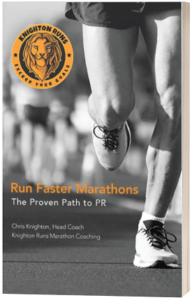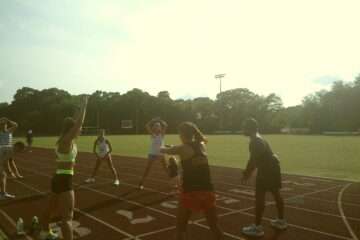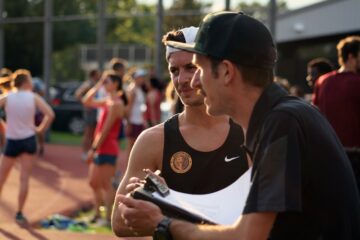How to Run the Boston Marathon for the First Time
By Coach Erica Knighton
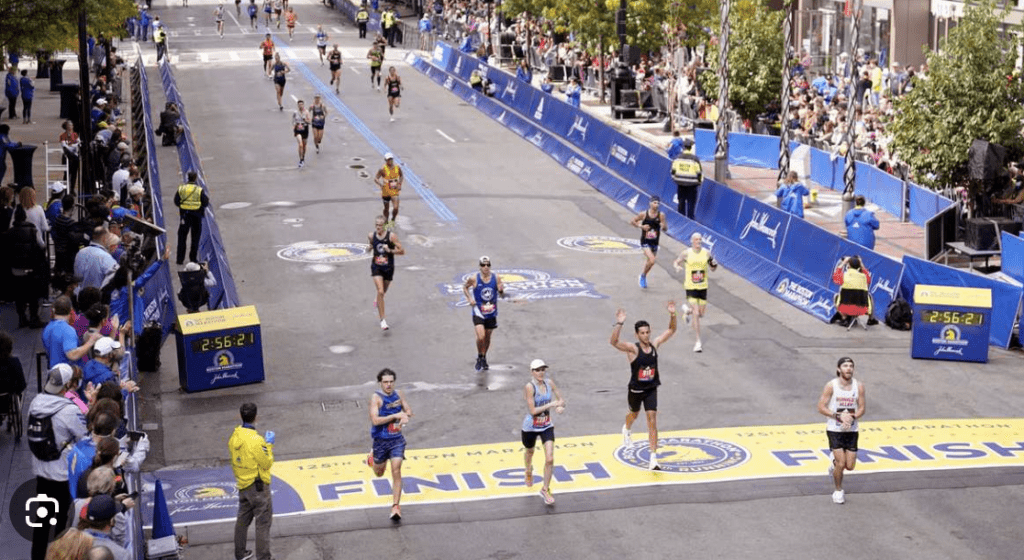
Disclosure: This article may contain affiliate links. When you buy through links on our site, I may earn an affiliate commission. As an Amazon Associate, I earn from qualifying purchases.
The Boston Marathon is more than just a race
Boston is a cherished tradition that holds a profound significance for the city and its people. If you are gearing up to run the Boston Marathon for the first time, you are in the right place!
Prepare to embark on an unforgettable journey as you tackle the historic and iconic Boston Marathon for the first time. Boston is the oldest marathon in the world and it is known for its challenging course. The race demands careful preparation, especially for first-time participants like yourself.
This article is jam-packed with advice on everything from dressing for race day to mastering the challenging course.
We’ll even dive into a detailed breakdown of the marathon route. From the starting point in Hopkinton to the iconic finish line on Boylston Street, it’s a 26.2-mile journey that epitomizes resilience and achievement.
How to Dress for The Boston Marathon
It’s not news that race day weather at the Boston Marathon is a real gamble. You could have a hot, humid 80F-degree day or a cold, rainy 35F-degree day. Hopefully, you have a general idea before you depart for Boston but bring multiple race-day clothing options.
It’s also important to bring some throwaways. What you race in and what’s comfortable on the bus ride to Hopkinton are likely two very different things, and there’s no bag check at Athlete’s Village. Whatever you bring you have to run with or toss. I typically pack an old pair of sweatpants and a sweatshirt that I’m okay with never seeing again.
How to Fuel for The Boston Marathon
Proper nutrition is paramount to being a successful marathoner. You must take on enough energy before a marathon by loading up on carbohydrates, which will help ensure the race goes to plan and that you don’t hit the wall. Carbohydrate loading in the final days before you run Boston for the first time is essential to ensure you have consistent energy from start to finish. You can read more about what we recommend in our article, How to Properly Carb Load Before a Marathon.
At this point, you should know what works best for you for in-race fueling. Fueling correctly on the run is a crucial part of getting you through 26.2 miles. For more information on marathon fueling, check out our article, Marathon Fueling – The Essential Guide to Run 26.2 Miles Feeling Strong.
Your long training runs were your test lab for what gels work, how much water you need, etc. Our general recommendation is to take a gel every 4-5 miles right before you pass the water stop. This way you can wash down your gel with fresh water. We also recommend alternating between drinking water and Gatorade at each aid station along the course.
The Boston Marathon Course
Considered a difficult course, with its rolling hills and challenging terrain, the legendary Boston Marathon route starts in Hopkinton, MA, and ends on Boylston Street in Boston, MA.
Below we’ve got a full roadmap from start to finish of the Boston Marathon course. We’ve included some of our favorite tips and tricks to help you run the Boston Marathon for the first time smart!
Mile 0 to Mile 4 – The Rural Start in Hopkinton and Ashland
Cross the beautiful blue and yellow start line and take a moment to appreciate that YOU are here! You will run the Boston Marathon for the first time today!
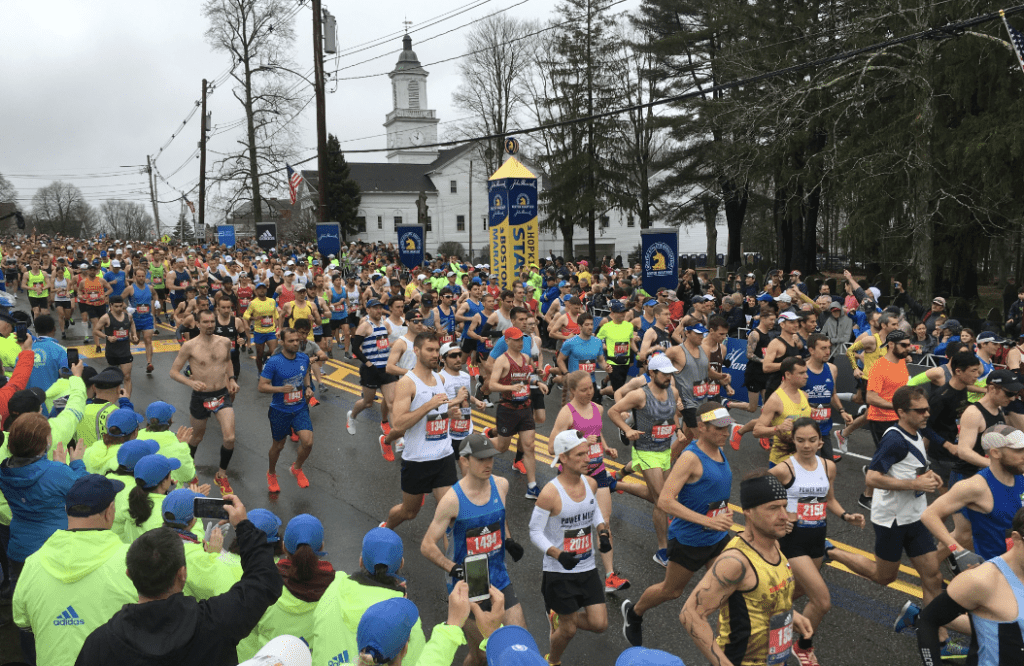
The race begins with an exhilarating downhill start, but runners should resist the urge to go too fast. There’s a slight uphill around 800 meters in, catching some off guard. You will be packed in with thousands of other runners for the first mile, which isn’t so bad since the spectators don’t show up until you’re out of Hopkinton. Don’t be fooled by the downhill start, though. You will encounter rolling hills throughout the entire Boston marathon course. The course continues with rolling hills and transitions from rural to commercial scenery. Runners pass notable landmarks like the clock tower and encounter iconic Massachusetts logos like Dunkin’ Donuts and the “T” for Ashland Commuter Rail station.
Mile 4 to Mile 10 – The Suburbs of Framingham to Natick
This section of the marathon course is an oft-forgotten one. It’s the most peaceful part, which takes you through Framingham and into Natick, where you’ll see mostly families out spectating in the miles before you hit the Wellesley College “Scream Tunnel.”
Once you get past the 10K mark and all the downhills, it’s a great opportunity to rein yourself in and zero in on your marathon goal pace. Lake Cochituate is the stand-out, so just take those moments to check in with yourself and enjoy the peacefulness heading into Natick, because it’s the last point of the course that will be that quiet.
Mile 10 to Mile 16 – The Suburbs of Natick and Wellesley
The beginning of Mile 11 is a little quiet. You’ll see the “Entering Wellesley” sign and not many spectators as you navigate the small rolling hills flanked by tall trees leading up to Mile 12 where you will hear a roar that only gets louder and louder as you approach Wellesley College. Here you go through the famous “Wellesley Scream Tunnel.”
Keep to the right if you want high fives, pictures, hugs or kisses, and tons of encouraging words shouted just for you. This part is, without a doubt, one of the most fun parts of the course, so enjoy it. Soak it all in, but don’t get carried away by picking up the pace too soon.
Mile 16 to Mile 21 – The Challenging Newton Hills
This stretch of the course, known as “The Newton Hills” make up the most challenging section of the Boston Marathon. It’s very important that you hold yourself back a bit in the first sixteen miles of the marathon to prepare for this difficult section. At mile 16, the course goes over Route 128, which is a long and steep bridge where there aren’t many spectators. You’ll pass Newton-Wellesley Hospital and then at 17.5 miles, you’ll make a sharp right turn onto Commonwealth Avenue. Turn the corner and you’ll start the ascension of the Newton Hills, which is a series of climbs that end with the notorious Heartbreak Hill.
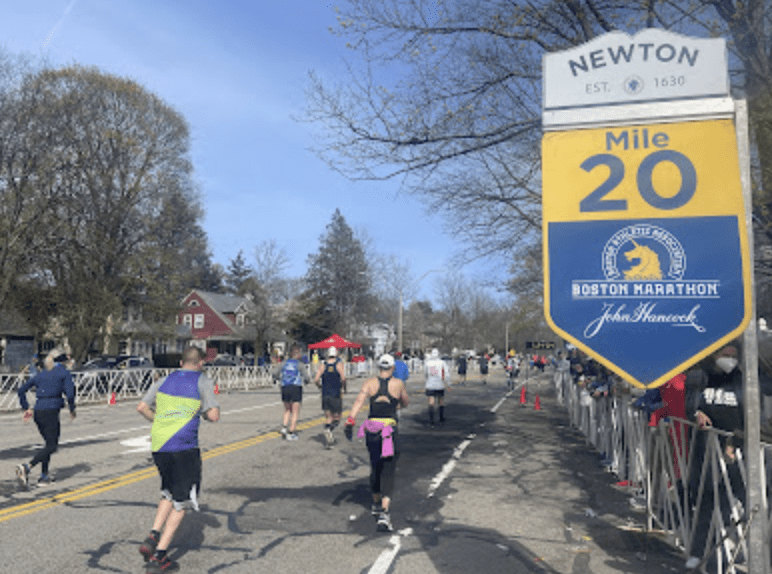
Heartbreak Hill has a 3.3% grade which, if you think about it, is not incredibly tough. But when your legs have been pounding for nearly 20 miles, it will feel quite challenging. Let the crowd carry you to the top of the hill. Relax, breathe, don’t worry about your pace—it will be slower here, and that is okay. Get ready to take advantage of the big downhill that comes after you crest Heartbreak Hill.
Once you’ve conquered Heartbreak Hill and descend past Boston College (at around mile 21), the course becomes quiet again. The stretch between the Chestnut Hill Reservoir and Cleveland Circle is tough mentally.
Hopefully you’ve done your best to stay comfortable in the beginning of the race, confident through the Newton Hills, and are now ready to run strong in the final miles of the race. It’s important to stay tough here.
Mile 21 to Mile 24 – Brookline to Downtown Boston
Many first-time Boston Marathon runners think the remaining miles after Heartbreak Hill will be smooth and easy. While the final miles of the course are net downhill, the Boston course still has a couple of tricks up its sleeve. It’s important to be prepared for this section of the course.
Keep your eye on the footing when you cross Beacon Street. You’ll be crossing over train tracks in this section and you don’t want to trip. Take advantage of the downhill over this section to maintain your speed and let it help carry you over the little incline just before 23 miles. While you may be starting to tire at this point, the crowd through Brookline is phenomenal and will keep you going strong.
At this point, if you’ve run the Boston Marathon course smart, you’ll begin to pass countless runners who’ve lost their legs over the first half of the race. Maintain your effort over the few small remaining uphills and utilize each downhill to shake out your arms, stay loose, and maintain your rhythm. The crowd will go crazy for those who look confident over this section, so use their support to help you get to the finish line. You’ve just got a few miles left now.
Mile 24 to Mile 26.2 – The Home Stretch, Kenmore Square and Back Bay
Just after Mile 24.5, you’ll see it – the Boston Marathon’s North Star, AKA the giant CITGO sign. Once you pass it a mile later, you’ll arrive in Kenmore Square, where the crowd noise will build to a roar.
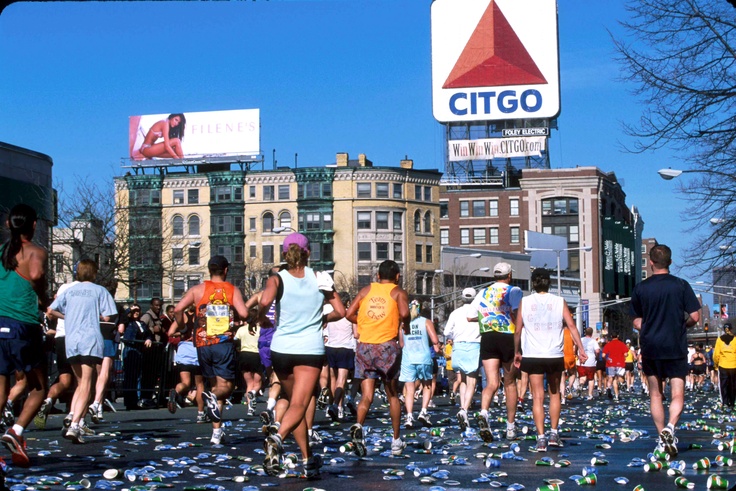
After passing through Kenmore Square, you’ll cross Mass Ave by going under the Tommy Leonard Bridge. The descent into and climb out of this underpass seems like a mountain this far into the race, but keep your head up, pump your arms, and stay strong. You’ve got less than a mile to go now. After emerging from the underpass, you’ll be home free.
Turn right on Hereford, left on Boylston, and begin your sprint down Boylston Street towards the finish line.
Take it all in. You’ve earned it!
You’ve run the Boston Marathon for the first time!
